This article is part of my ongoing “Indie Fighting Game Thursday” review/retrospective series, now on supercombo.gg! This week we talk about ROBO OH, a retro, 2D pixel art game available on Steam! This article was originally published on my Medium blog and has been ported to Supercombo.gg for preservation and sharing it with more people in the fighting game community!
The NES era gave us some very rough, early attempts at porting fighting games to home consoles, including precursors like Ye Are Kung Fu, cancelled versions of the original Street Fighter, and extreme bootleg experiences like an unlicensed Street Fighter 2 conversion. While that would be rectified by the Super Nintendo in the following generation, the aesthetic of those earlier attempts at cooking colorful settings with just a bunch of pixels is not completely lost. For today’s indie fighting game, we go back in time, while steadily moving forward, thanks to the 8-bit-era-inspired fighting game ROBO OH, by Foxy Boxy Games!

Who’s gonna be the king?
King of the Robots
ROBO OH (literal translation: “robot king”) is a traditional fighting game, starring 11 playable characters, heavily inspired by the giant robot tropes often found in anime and Super Sentai TV series aired between the 80s and the 90s.
The game has a distinct NES aesthetic, with limited color palettes, a CRT filter, 4:3 screen aspect ratio, and music that pops out directly from the 80s, with those sweet on-chip synth effects.
However, the gameplay is rather smooth and far from the sluggish speed of the games it is inspired by. ROBO OH is more “how we fondly remember NES games” than “how real NES game played”, which is definitely a plus, as it takes the best of both worlds and doesn’t reproduce the flaws of those long gone titles for nostalgia’s sake.
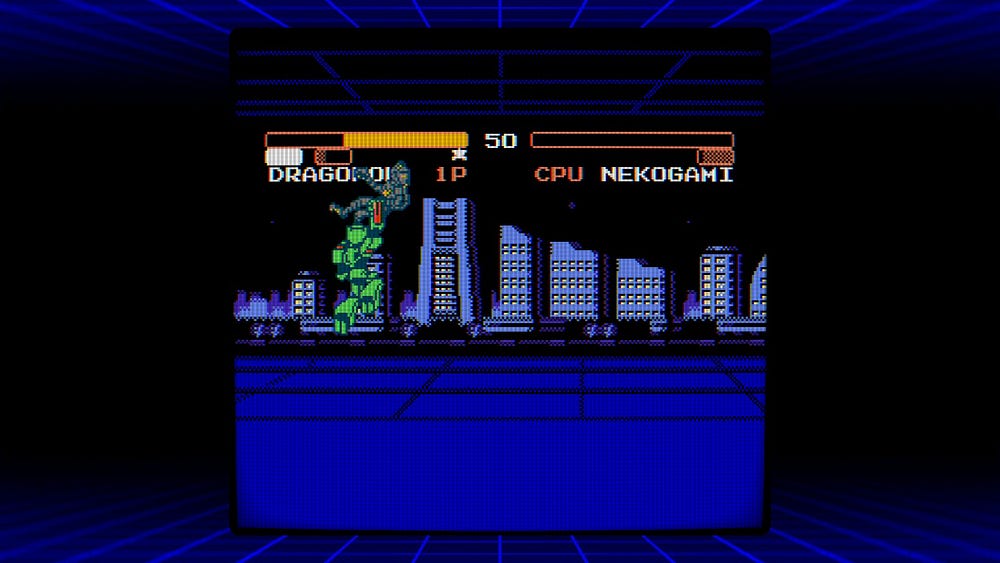
Dragonoh is the shoto we didn’t deserve.
Classic gameplay, with some twists
ROBO OH limits its inputs to four directions plus two buttons — Light Attack and Heavy Attack. Characters can jump, crouch, and dash on the ground. Attacks are blocked by pressing back or down back, like in most traditional 2D fighting games.
Each character has access to six normal moves (two standing, two crouching, two airborne), one command normal, performed by pressing forward or backward to together with the Heavy Attack button, and at least two special moves. Grabs are performed by pressing the Heavy and Light Attack buttons together. This specific combination can be assigned to another button as a macro, which is pretty handy to perform moves that require super meter.
The inputs for the special moves are rather standard, albeit skipping diagonals and using only the base directions: the most common inputs are [down, forward, attack], [down, back, attack], and [forward, down, forward, attack], which is functionally equivalent to a dragon punch motion.
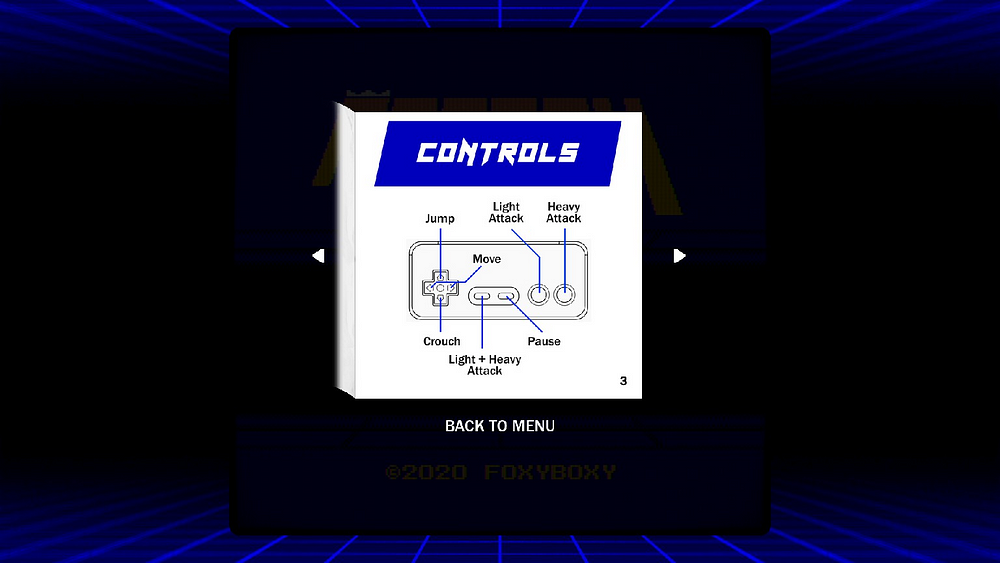
The in-game manual shows the control scheme on a simplified controller, which seems like a copyright-friendly NES pad.
There is a super meter, divided into three stocks. A player can build up meter by hitting or being hit by the opponent, but not by whiffing attacks.
Each special move has one EX variation, performed by inputting the special’s motion and pressing both attack buttons at once. EX moves cost one stock of meter each.
There are also super moves, which are universally performed by inputting [down, forward, down, forward, attack] and cost the entirety of the super meter. The damage of super moves depends on how many stocks of super meter were available at the moment of activation, while the other properties of the move, such as animations and frame data, are not affected by it.

Megastar is a sort of Sagat function, with very good fireballs and an invincible raising double fist with a long recovery. Compared to other characters, he can feel quite weird when played as for the first time, due to how “floaty” his jump and dragon punch special are.
HYPERDRIVE!
There is one last way to burn through your super meter: Hyperdrive mode. By tapping forward or backwards twice during a move — either on hit, block, or whiff — for the cost of two stocks of meter, your character will cancel the current animation with a dash and will glow blue for a limited amount of time. During this time, each of their attack can be used to juggle the opponent in the air, but the character won’t have access to any of their EX specials.
This is important because, aside from some very specific exception, only EX specials and super moves can juggle an opponent. Special moves and normal moves will phase through the falling foe, as if they weren’t existing, while moves that consume super stocks and some command normals can be used to keep the combo running.
Hyperdrive turns these rules on their head, allowing for some rather impressive damage, especially in the corner. This can lead to literal touch-of-death combos, especially on characters with lower than average health, like Ringking.
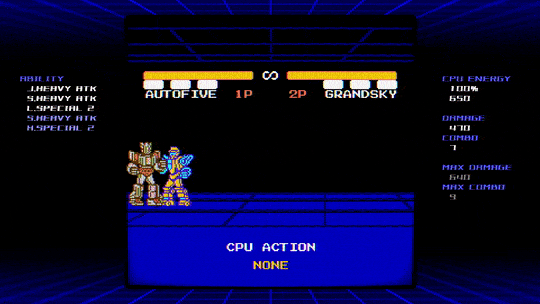
WHY? Why does Autofive’s Special 2 deal SO! MUCH! DAMAGE?!
Eleven flavors of giant mechs
The eleven playable characters have a variety of fighting styles, some of which are sort of referencing well-known character tropes: Ringking has access to specials similar to Street Fighter 2 Boxer’s dashing straights, and is a rushdown character with low health total; Dragonoh has a dragon punch (duh!), a blue fireball and a red fireball, much like a certain shoto protagonist; Megastar has access to fast low and high projectiles and an invincible uppercut, like the historic rival of said shoto protagonist.
However, this is where the similarities end, as all characters feel like fairly unique takes on the subject. For example, Autofive can detach his body parts and use them as short-range projectiles, or decompose himself into his components to dash through the opponent, allowing for some cross-up shenanigans; Yumelody has a projectile-reflecting spin attack, a dashing punch and an invincible uppercut; Masamioh has something akin to Zangief’s lariat, mixed in with original tools — like dropping from the sky in the form of a maneki neko statue; Grandsky is a weird character who can turn into a zeppelin for fast air movement; Nekogami has probably the best gound mobility, plus a projectile super and something that resembles a Blanka Ball; Heavytex has a spinning piledriver, accessed via a dragon punch input, and a long range projectile with long recovery;

Bold words for someone who’s getting bodied, Maxcyber.
A separate discussion must be done for the arcade boss, Maxcyber, who is playable from the beginning and — just like a Street Fighter 4’s Seth — uses a mishmash of special moves from other characters: Megastar’s projectiles, Masamioh’s lariat, Dragonoh’s dragon punch, Ringking dash upper and Autofive component dash (the only move in the game with a half circle backwards input). However, he only has access to the Heavy and EX version of these moves: performing the motions followed by the Light Attack button won’t have any effect.
Uchuzine joins the fray!
The eleventh character is a surprise crossover with another Japanese indie fighting game: Uchu Mega Fight, a PICO-8 game made by the developer Uchuzine. On the 17th October, 2021, the developers of both games released a joint trailer to celebrate a character exchange: Autofive from ROBO OH was added to Uchu Mega Fight, while Uchuzine was chosen to represent his original game in ROBO OH.
Compared to other characters, Uchuzine has access to just two special moves — a projectile attack and a sort of tornado kick. His EX moves, however, have significantly different properties: his EX projectile travels diagonally upwards instead of horizontally, while his EX tornado kick moves vertically, with almost no forward momentum.
Aside from these small changes — and a relatively low damage output, Uchuzine plays like a ROBO OH character, following the same rules, mechanics and combo structure. He is surprisingly versatile and fun to play, and this version of him is a faithful conversion of his Uchu Mega Fight standard form.

While crossing the barrier between games, Uchuzine brought his own stage and an 8-bit remix of his theme song with him.
What’s in the box?
ROBO OH features a limited amount of game modes: a story mode with pixel-art arcade ending, with the goal of beating Maxcyber and become the new Robot King; a local versus mode (either player vs player, player vs AI or AI vs AI); a training mode, with some basic options and a handy “last combo” pane, which makes it easier to reproduce sequences that were found by chance. The in-game options control the round timer, the AI difficulty and toggle both music and sound effects on or off.
There are also a set of advanced options, which can be accessed in a separate menu at the press of one button. This additional menu contain a fair degree of technical, quality of life settings, ranging from controls for the master volume, to widescreen video support, to CRT filter toggles, to showing the game manual, which is rendered in an exquisite retro fashion.

The digital manual is nothing short of an amazing, nostalgic throwback to the printed manual era, oozing style at every page.
The game’s arcade/story mode has an interesting twist: between each set of fights, the player can freely assign points to each of four main stats, in order to power-up their character. Each victory awards two points, for a total of ten points maximum that can be gained before the last match against Maxcyber. The overall impact of the stat changes is pretty small, but not insignificant.
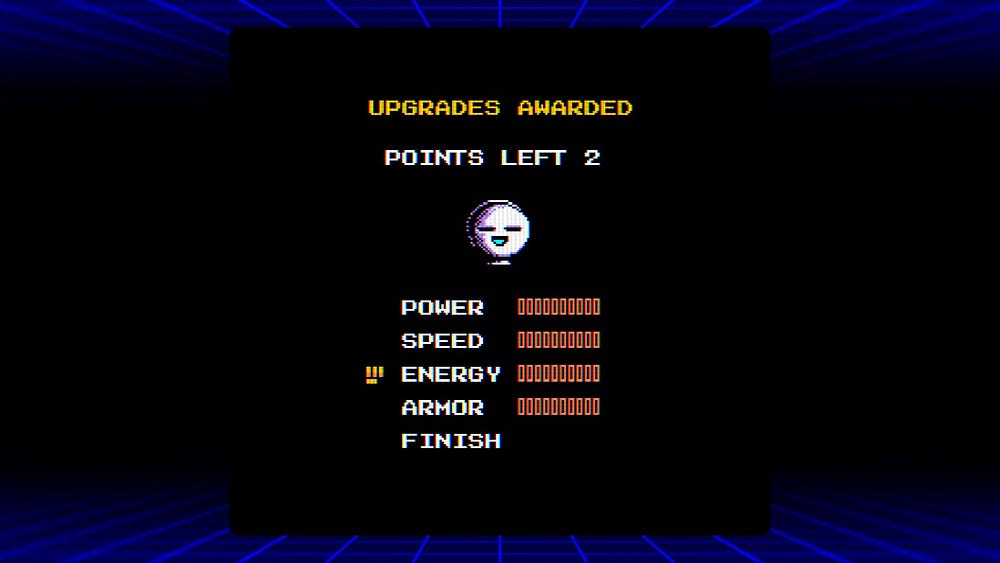
The stat point system during story mode is a welcome addition to shake up the formula a bit, though the overall impact of the improved stats is rather small.
Fighting the CPU
The AI has three levels of difficulty, and it can be fairly interesting to fight. Characters with an invincible special move (Dragonoh, Megastar, Maxcyber and Yumelody) will abuse the heck out of it, by reading your inputs and performing them only if you are jumping or attacking while they are knocked down. The difficulty is nothing to write home about, but some characters can be more frustrating than others. Megastar and Autofive were the worst offenders during my playthrough, forcing me to carefully consider every jump and interaction while in neutral. Autofive’s projectile attacks are extremely damaging, and being hit by them while failing to jump on him can be very painful.
The only slightly sour note is Maxcyber: despite being the titular arcade boss and having access to the best specials in the game, his AI behavior is not as broken as one would expect from a final boss, being almost easier than some of the regular characters. He will spam his invincible reversals like there is no tomorrow, sure, and only do that if you can’t punish them, but this doesn’t make him nearly oppressive enough, failing to live up to his self-generated hype.
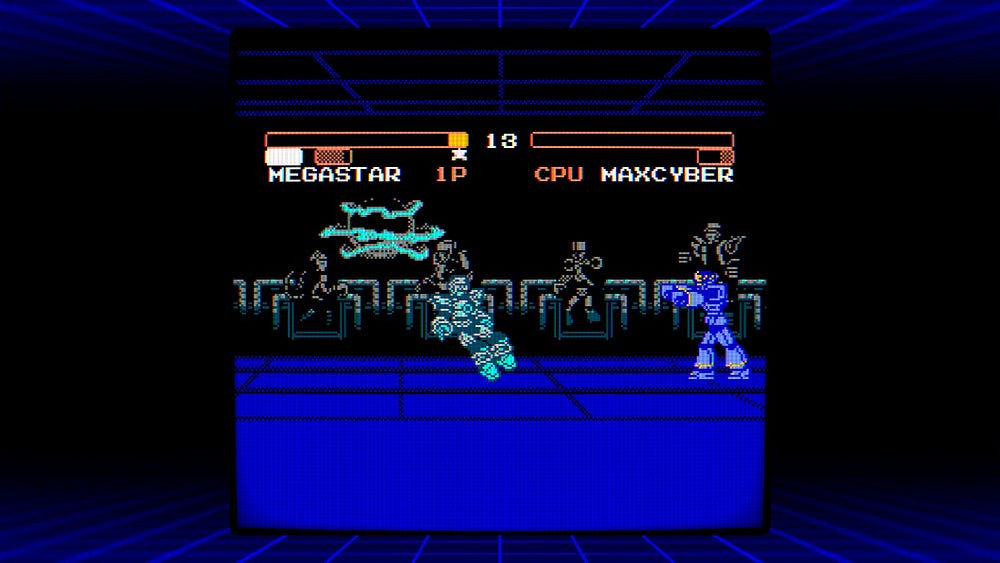
Maxcyber cannot catch a break. He is on the weaker side of arcade final bosses encountered in fighting games.
The woes with input buffers
The only real downside of ROBO OH, except the lack of online multiplayer, is its rather imprecise input buffer. Sometimes, it feels like it has too much leniency, sometimes it feels like it hasn’t nearly enough, especially when playing on pad. I had often triggered dragon punch specials instead of [down, forward] ones because of a forward input that was input several frames before, or got an EX move instead of a round-ending super because one of my down directions were eaten by a diagonal.
A little bit of polish in this department could improve the playability a lot, but this is a minor gripe, as the game is responsive enough and — outside of minor issues like these outlined above — perfectly serviceable.
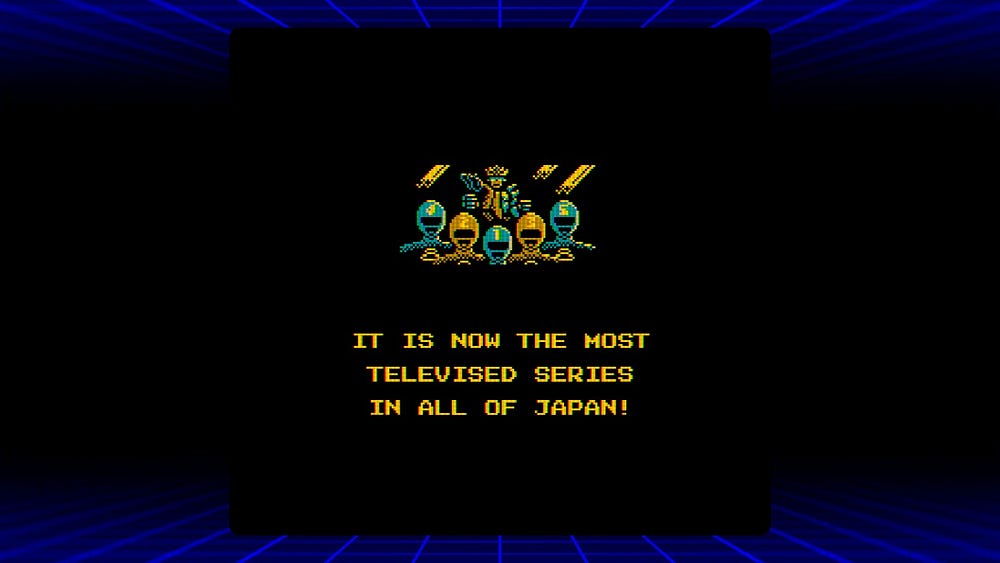
I am not going to lie: the ending cutscenes are the right mixture of nostalgia, sincere homages and freshness.
How to play it
ROBO OH is sold on Steam at the price of 1.59€, and includes any future update the game will receive. It has no netcode, but can be played online using middleware like Parsec. The game has also a small player-managed Discord server.
Game summary
Name of the game: ROBO OH
Developer: Foxy Boxy Games
Available on: PC (Steam)
Price: 1.59€/1.99USD
Year of release: 2020
Engine: unknown
Netcode: none (Parsec)
Status: complete
In one sentence: 2D retro fighting game with giant robots and an interesting dash cancel system.
Special thanks to @nedmanstool for proofreading the article and to the Community Lab server for sharing knowledge and tech for the game.
If you are interested in more coverage about indie fighting games, you can find me on Twitter at @AndreaDProjects

